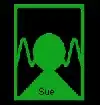Yerkish
Yerkish is an artificial language developed for use by non-human primates. It employs a keyboard whose keys contain lexigrams, symbols corresponding to objects or ideas.[1]
| Yerkish | |
|---|---|
| Lexigram | |
| Created by | Ernst von Glasersfeld |
| Setting and usage | Use a keyboard to punch keys with logograms |
| Users | 3 (apes) |
| Purpose | |
| Language codes | |
| ISO 639-3 | None (mis) |
| Glottolog | None |
A lexigram represents a word but is not necessarily indicative of the object to which it refers. Lexigrams were notably used by the Georgia State University Language Research Center to communicate with bonobos and chimpanzees. Researchers and primates were able to communicate using lexigram boards made in up to three panels with a total of 384 keys.[1][2]
History

The language was developed by Ernst von Glasersfeld and used by Duane Rumbaugh and Sue Savage-Rumbaugh of Georgia State University while working with primates at the Yerkes National Primate Research Center of Emory University in Atlanta, Georgia. Primates were taught to communicate by means of a lexigram board, a computerized array of keys labeled with lexigrams. Von Glasersfeld coined the term "lexigram" in 1971, created the first 120 of them, and designed the grammar that regulated their combination. This artificial language was called Yerkish in honor of Robert M. Yerkes, the founder of the laboratory within which the lexigrams were first used.
The first ape trained to communicate in Yerkish was the chimpanzee Lana, beginning in 1973 within the context of the LANA project. Von Glaserfeld created approximately 150 of the first words in the Yerkish language, and went on to use 25 of them in his initial experiment with Lana - a chimpanzee who researchers were hoping would not only interpret the Yerkish language, but would also participate in communication with others through this newfound language. A keyboard was created for Lana with each key representing various nouns or verbs such as food, eat, apple, drink, etc. After pressing a certain key, the corresponding item would emerge from a food dispenser placed next to the keyboard, and through a series of experiments, researchers hoped that Lana would learn to interpret what each key would correlate to and learn to meaningfully communicate her requests.[3]
See also
Notes
- "Interactive Lexigram, History of Ape Language". Great Ape Trust. 2010. Archived from the original on May 20, 2010.
- Jeffrey Kluger, "Inside the Minds of Animals", Time, August 5, 2010.
- Bettoni, Marco (2007). "The Yerkish Language. From Operational Methodology to Chimpanzee Communication" (PDF). Constructivist Foundations. 2: 32–34 – via http://weknow.ch/marco/A2007/CF_EvG/Bettoni_2007_The_Yerkish_Language.pdf.
References
- Rumbaugh, D. M. ed. (1977) Language Learning by a Chimpanzee. The LANA Project. New York, Academic Press
- von Glasersfeld, E., Department of Psychology, University of Georgia. The Yerkish language for Non-Human Primates. American Journal of Computational Linguistics, 1974, 1.
- Bettoni M. C. (2007) The yerkish language: From operational methodology to chimpanzee communication. Constructivist Foundations 2(2-3): 32–38.
- Rumbaugh, Duane M.; Gill, Timothy V.; Brown, Josephine V.; von Glasersfeld, E. C.; Pisani, Pier; Warner, Harold; Bell, C. L. (September 1973). "A computer-controlled language training system for investigating the language skills of young apes". Behavior Research Methods & Instrumentation. 5 (5): 385–392. doi:10.3758/BF03200213.